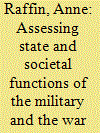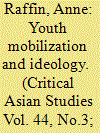| Srl | Item |
| 1 |
ID:
101326


|
|
|
|
|
| Publication |
2011.
|
| Summary/Abstract |
Studies on the military in Vietnam today see a concurrence between the changing role of the army-its growing economic role as well as its role as a tool to control the Vietnamese population-and the changing economy and international environment. How do we make sense of this evolution and its impact on civil-military relations in terms of power relations and authority? This study seeks to provide an analytical framework that shows how the military is not a homogeneous entity but rather is made up of various groups that derive uneven benefits from the post-cold war situation. The author's contribution is primarily at the conceptual level, stressing the dynamics of power relations among the military, society, and state from a Weberian perspective. Doi moi, as an era of economic and social change, has redefined power relations. The author also emphasizes the generational and historical elements in civil-military relations that are specific to Vietnam.
|
|
|
|
|
|
|
|
|
|
|
|
|
|
|
|
| 2 |
ID:
115032


|
|
|
|
|
| Publication |
2012.
|
| Summary/Abstract |
This article, based on archival data, tracks the evolution of youth mobilization in Cambodia from the Vichy French colonial National Revolution duringWorld War II through the country's revolutionary implosion under Pol Pot in 1979. Successive regimes relied on young people to consolidate power and protect the nation from external and internal threats. An overarching ideology of agrarianism structured the political beliefs of the leaders and committed cadres of these youth corps, ranging from an ideology of civic agrarianism under colonial officials and Sihanouk, to Lon Nol's military agrarianism, and finally to the Pol Pot regime's mobilization of youth via an ideology of revolutionary agrarianism that aimed to create a utopian agrarian nation. While the lives of young Cambodians had traditionally been shaped by two institutions, the family and the sangha, the advent of state-sponsored youth organizations in the mid twentieth century provided a new space for young people beyond the family and existing religious organizations. In this respect, the author argues, the Cambodian youth corps was part of modernity. In spite of this development, those in power continued to mobilize young people via ideologies based on agrarian values, an idealization of the past, and the desire to create a "new man." The state's instrumental use of youth organizations during this period can thus be seen as a type of reactionary modernism.
|
|
|
|
|
|
|
|
|
|
|
|
|
|
|
|